Akun jann!
Friday, March 30, 2012
- Silkroad
After my intestinal flora had calmed down a bit thanks to the antibiotics, I continued on Tuesday as planned. Due to the heat, I try to leave as early as possible. At 4:30 clock rings the alarm clock. I sit in the saddle for half an hour until dawn at 6 o'clock. The mood at this time I love and the fresh morning breeze is gorgeous.
Mostly after five hours of driving I put a siesta. When I lay in the shade at a school, an English teacher came by. He had a lot of fun talking to a foreigner. Luckily after a while he had to have lunch and I could continue my beauty sleep.
Adam told me in Battambang that he mostly spent the night in the temples in Cambodia. I tried that on the first evening. The monks have probably never seen a Velonomaden with tent and gas stove. Only when I put my mosquito net over the tent entrance they were reasonably calmed down. This method also comes from Adam's Idea Kitchen. This allows you to open at night outdoor and indoor tent and the fresh air circulates better.
In the middle of the Cambodian basin is the Tonle Sap, which is connected to the Mekong River by the Tonle Sap River. During the rainy season from July to October, the Mekong floats so high that the water, contrary to its direction of flow, pushes up the Tonle Sap River and feeds the lake, which swells from 2,500 km² to up to 20,000 km². This makes it the largest lake in Southeast Asia.
The Mekong, the largest river in Southeast Asia, flows through Cambodia in a north-south direction for 500 kilometers. He is usually over 1.6 kilometers wide. Cambodia is as flat as Holland. After all the mountains in Central Asia, China, Vietnam and Laos, it is really relaxing to just cycle all day long. The wind was also very gracious and blew only slightly.
So I was able to crack the 100km mark almost every day. On the first day, after about 90km, my rear wheel suddenly lost air. A metal pin had drilled through the mantle. My second record on the whole trip. Since leaving Switzerland I have never changed this hose. When I wanted to use it again, the valve came off. No wonder, after 12 months, the material must be so brittle! I gave some of my clown's noses to the little spectators.
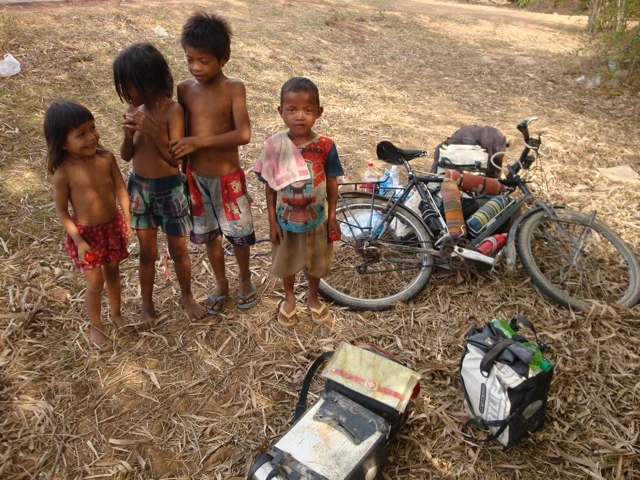
At another siesta in a temple, the young monks also came by. A monastery always consists of a pagoda and a temple. When I photographed the temple from the outside, they opened the entrance especially for me. First, they wanted me to pray in front of the Buddha. Since I had never done such a thing, one of the monks knelt beside me and gave me instructions. It must have been a pretty funny show. The other monks cringed with laughter.

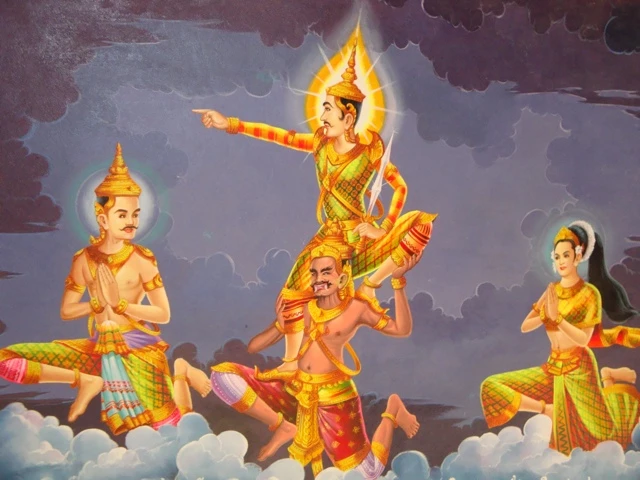
For a little while, people here remind me of their time behavior in Iran. You are never alone. As soon as you get off the bike you are surrounded by a horde of people. Maybe I'm just really pretty picture?

Cambodia has around 14.5 million inhabitants. According to UNICEF estimates, there are about 670,000 orphans living in Cambodia. The main populations of Cambodia are the Khmer, who officially make up 85-90% of the natives. This makes Cambodia the most homogeneous country in Southeast Asia.
The largest minorities are the Vietnamese (5%), the Cham (up to 3%) and the Chinese (about 1%).
In Cambodia, around 93% of the population is dependent on Theravada Buddhism, which is widespread alongside Cambodia in Thailand, Laos and Myanmar. Theravada Buddhism, which supplanted Hinduism and Mahayana Buddhism from the 14th century, was the state religion until 1975 and again from the late 1980s. Today it is legally enshrined in the constitution. Under the Khmer Rouge, most Buddhist monks were killed and nearly all the wats and mosques were destroyed. In the nineties, most of the faiths were rebuilt - today there are again 59,500 monks and 3,980 wats.
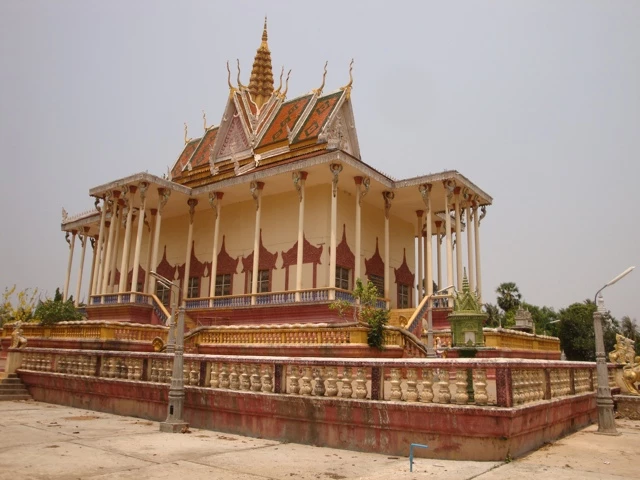
At the Sunday Guesthouse, I found the perfect place to stay and was able to get my Laos visa for $ 45 and met Philip shortly afterwards. It was nice to see him again after such a long time. The last time we met in Uzbekistan was when he was traveling with Fred and Herbert herbertborn.de. So there was a lot to tell. Philipp met his current wife here and spends the last weeks of his trip with her. He will soon be a dad, too. Congratulations!
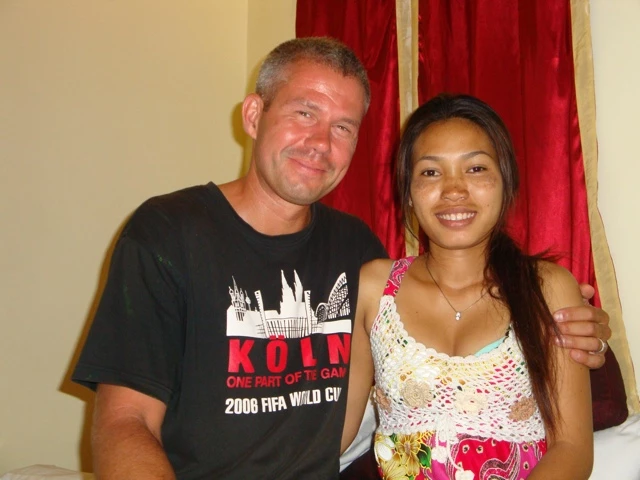
From 1884, the French used arbitrarily French officials, making Cambodia de facto a colony of France. Officially, the monarchy remained, but the dependency was complete. Some "relics" from the colonial era have been preserved to this day. In part you can still see the colonial buildings, there is the best baguette and some older people even speak French. C'est magnifique!
As a vegetarian, the food seemed repulsive to me at first. But soon I discovered a few culinary delights. Sugar cane juice, fried bananas, rice and pasta with vegetables and egg are among my favorites.
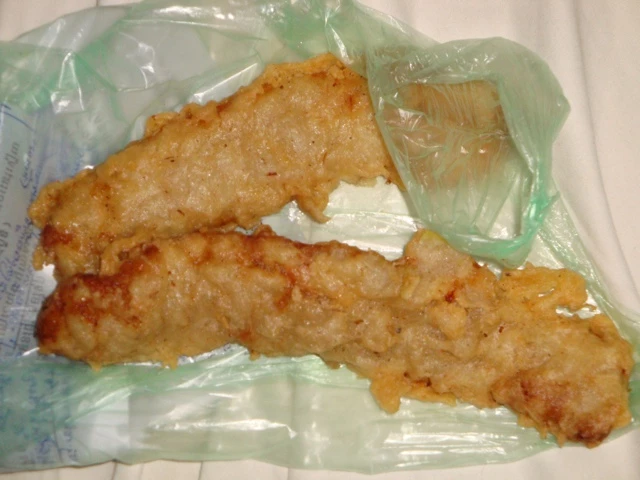
The next day, I first visited the Tuol Sleng Genocide Museum, which is very close to my guesthouse.
The Tuol Sleng Genocide Museum is the former Khmer Rouge S-21 jail and serves as a reminder of the crimes committed there. The building complex is a former school of the city, which was used by the Khmer Rouge after the conquest of Phnom Penh as a prison with systematic torture of the inmates. For this purpose, the four buildings of the school in edged barbed wire were bordered and converted the classrooms into prison cells and torture chambers. Barbed wire netting in front of the exteriors of each building should prevent desperate prisoners from committing suicide.
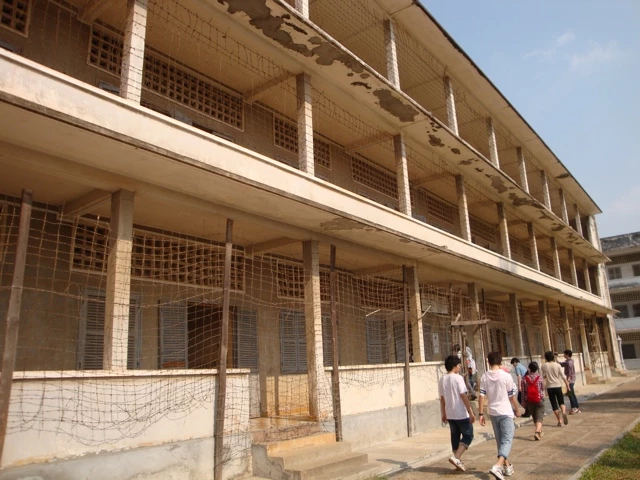
Between 1975 and 1979, between 14,000 and 20,000 people from all over Cambodia were imprisoned there, including members of the Khmer Rouge who were considered traitors in the eyes of the Khmer Rouge leadership. About 1,720 people worked for the torture center. Like the Nazis, the Khmer Rouge meticulously kept a record of their atrocities and every prisoner of the S-21 was photographed. In the corridors, the pictures are now exhibited. At the sight it shudders. Some of the visitors cried and I had to swallow several times.
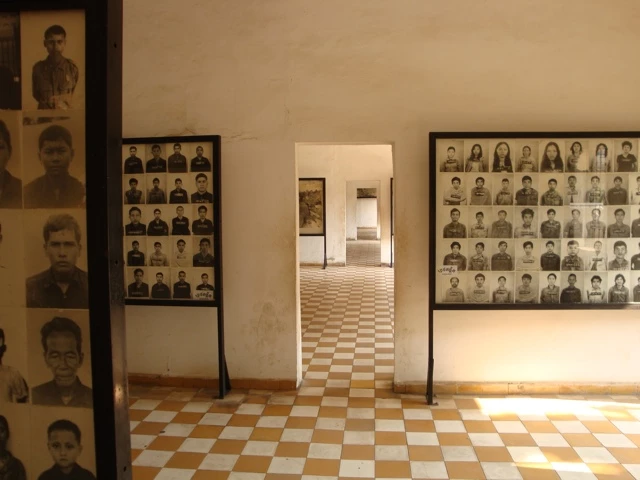
Every prisoner had to submit to strict regulations; such were laughing, crying, talking and other communication prohibited. Offenses were punishable by flogging or electric shocks, and the victims were not allowed to scream.

As torture methods came in the S-21 electric shocks, immersion in water vats, waterboarding, hanging on a gallows to the onset of unconsciousness, with the hands behind the back were tied with a rope and the victim was hung up, thumbscrews and the insertion of Acid or alcohol used in the nose.
Although many people died from it, it was frowned upon deliberately killing them because the Khmer Rouge wanted confessions. Those who survived the torture were beaten with shovels on the killing fields of Choeung Ek, just outside the city, and their throats were cut to save ammunition.
The "better off", meaning important members of society, were held in single cells and chained to a cot. Their family members and all other inmates, who were not expected to be significant, were housed in mini cells of about 2 square meters and chained to the wall. These minicells were created by further subdivision of the former classrooms. As a toilet, the prisoners had a shoebox-sized container at their disposal. Some cells were made of wood, others of bricks.
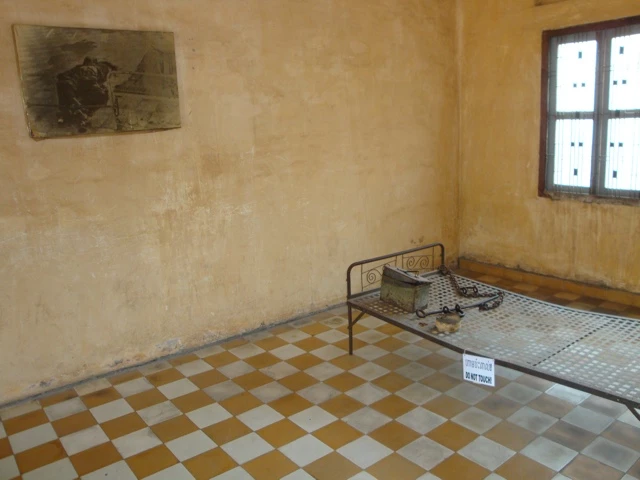
In addition to torture, there were isolated cases of in-patient surgery to improve the anatomical knowledge of the medical staff. In addition, blood was taken from inmates to provide transfusions for wounded Red Khmer fighters. In about 100 victims, this treatment resulted in death due to blood loss.
When the prison was released, 14 inmates were still alive, and more died because of being too weak, starving, and too ill. After a week, there were only seven of a total of at least 14,000 prisoners who survived S-21.
The former head of the torture center, Kaing Guek Eav, known under the pseudonym Duch, was interrogated in 2007 as part of the so-called Red Khmer Tribunal and has been numerous crimes. Duch was found guilty of being involved in the killing of at least 14,000 people. On July 26, 2010, he was sentenced to 35 years imprisonment, which was immediately reduced by five years to 30 years for his illegitimate detention. He had already served eleven years at the time of the verdict. In February 2012, the sentence was increased to life imprisonment in an appeal.

At the end of July 2009, the archive of the Tuol Sleng Genocide Museum - consisting of 4,186 written confessions, 6,226 biographies, and 6,147 photographs, among others - was registered by UNESCO as Memory of the World. After the visit, I made my way to the National Museum. There you get a detailed record of the mighty empire of the Khmer. The heyday of Cambodian high culture. For me it was a nice change from the Genocide Museum and very interesting, as many sculptures from Angkor are exhibited here.

In the evening I was allowed to celebrate with Philip and his wife for a small birthday party. Back at the guesthouse I got my passport back with the Laos Visa. Sometimes formalities can be so easy! Philip and I drove the next morning by bike to the 16km distant Choeung Ek or also known under the name "Killing Fields".
Choeung Ek, a former orchard and Chinese cemetery about 17 kilometers south of Phnom Penh, is the most famous of the so-called killing fields, where the Khmer Rouge regime executed about 17,000 people between 1975 and 1979. Mass graves with 8,895 bodies were discovered here after the fall of the dictatorship. Today, Choeung Ek is a memorial site marked by a Buddhist stupa. The stupa has acrylic glass walls and is filled with more than 5,000 human skulls.
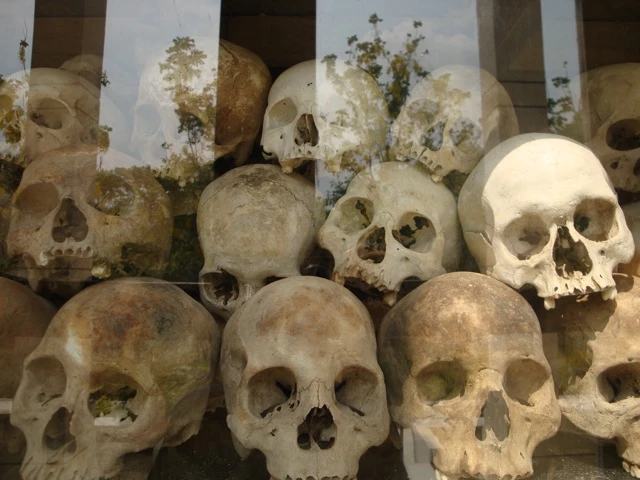
Duch, the head of S-21, was brought here in 2007 for testimony. Before the "Killing Tree", on which babies were beaten until they died, he should have collapsed and filed a confession.
The most macabre is the fact that until 1991 the UN allowed the Khmer Rouge to attend the UN General Assembly. For twelve years, the murderers represented their victims. On 22 March 2012, Geneva examining magistrate Laurent Kasper-Ansermet resigned from the Khmer Rouge Tribunal in Cambodia.
The UN is very concerned about this. Reason for Kasper-Ansermets resignation is likely to be mainly head of government Hun Sen, who himself had belonged to the leadership of the Khmer Rouge and wants to limit the legal work nzz.ch/ruecktritt_des_genfer_richters_in_kambodscha_beunruhigt_uno-1.16012716. On the way back we were surprised by a downpour. That gave us some time to think about the visit under a canopy.

While walking on the promenade in Phnom Penh Philipp showed me the "recycling temple". We call him that because people at the entrance buy flowers and gifts to put Buddha in front of them. However, since the temple is rather small, the employees have to dispose of the items through a side window in a hollow beforehand. Otherwise he would be overcrowded pretty quickly.

In the evening I made myself in the guesthouse a pack Kellogg with real milk. That was the last time I had that in Kyrgyzstan. Just heaven! In Cambodia you can either pay with Dollar or Riel (4'000Riel = 1 $). As a tourist, I think that's pretty handy.


After another day in the capital, I had to say goodbye to Philipp and his wife. Thank you two and see you soon in Cologne! Since my pants had to be sewn again by the accident, I looked for a seamstress in the market. This was soon found and did not want me to pay her for it. Wow!
Back early in the morning, it was first about 40km back along the national road A6 until I took the turnoff to the secondary road 223 direction Kampong Cham. The road soon changed from asphalt to dirt track and with the many holes it was sometimes quite a challenge to get ahead with the bike. The trip along the Mekong River was a great experience for a variety of reasons: oxen, overloaded bicycles and motorcycles, traditional villages, mosques and Buddhist temples, mango trees, banana and coconut palms, and much more.
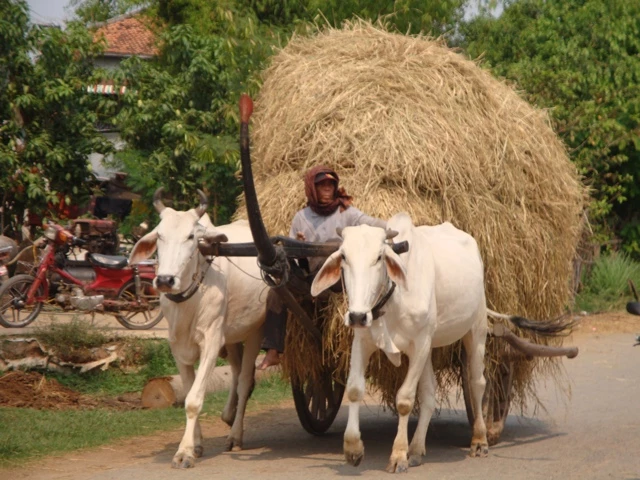

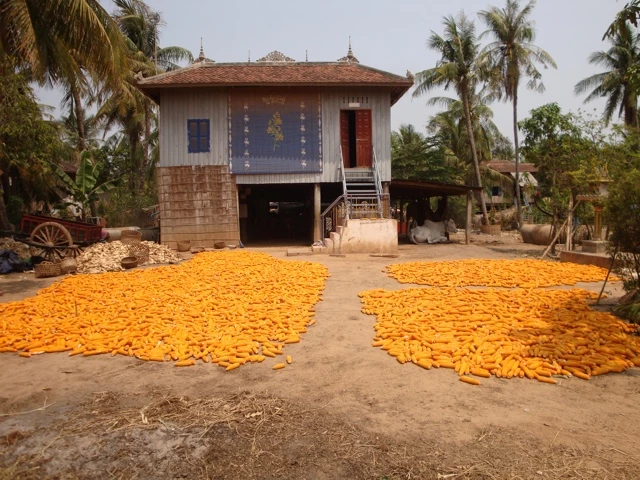
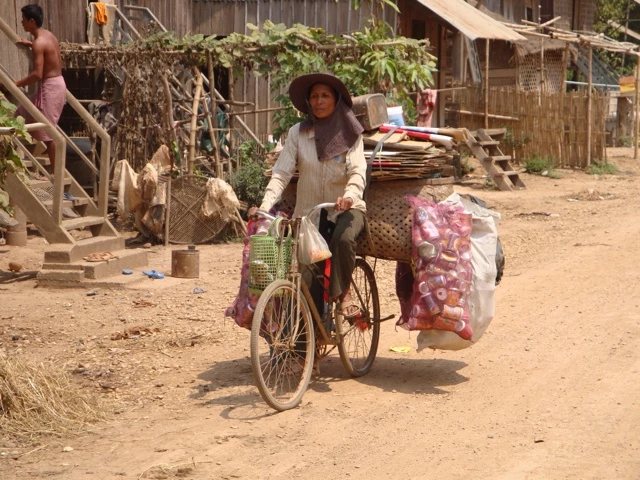
During a siesta, an English teacher came by again. After all, I was allowed to take a picture of him and could continue driving for an hour.

The kids keep shouting "Bye Bye, Okay, Hello" if you pass by. And there are many children in Cambodia, many children even! When I fall asleep I sometimes hear their calls and the shoulders hurt from the eternal wave.
Up to Kratie, it went up the river of the Mekong for two days. Once, when I wanted to sleep in a temple, a monk gave me some good advice. He said I should never sleep under a coconut palm tree otherwise I might not survive the night. Aha! Thanks for the tip. I like to cook myself. My favorite dish is fried noodles with vegetables. In a temple I used one of the stupas as a cooking place.

The monks were at 4:30 when I usually got up at the morning prayer and stopped only at sunrise. That's what I call perseverance! After a short shopping in Kratie the road soon led away from the Mekong. The flora changed abruptly and from the green landscape changed everything into dry fields and the heat increased noticeably.


My water consumption is now again at 7-8 liters a day. Almost as much as in Iran. Fortunately, it cools down significantly at night and you can reasonably enjoy sleeping in the tent. After a long search, I found a siesta place under a tree and was again besieged by monks and locals.

On the way I drove past some mines warning signs. A sign that not all areas in the country are already decminted.
In Krieng I found a small monastery. The monks were also very nice here. Only the neighbors celebrated a deafening party until midnight. Sleep was out of the question.
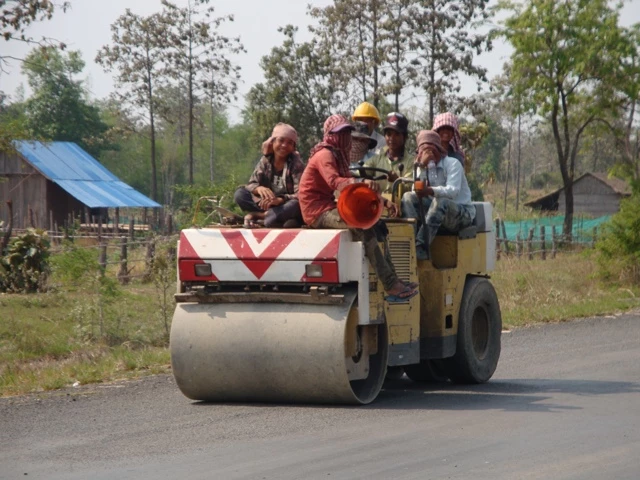
Fairly tired, I got on my bike the next morning and drove to Stung Treng. It was the first time in Cambodia that I encountered a nice headwind. One of my mortal enemies. The proximity to Laos is also noticeable here. There were a few increases. By noon I was already in Stung Treng and found in the Riverside Guesthouse the optimal accommodation.
Exactly on this day a year ago I started from Wettingen. Already 12 months in the saddle. My trip through Asia has not come to an end and I would like to thank all those who supported and accompanied me during this time. For me, a dream came true with this trip. On the last blog there is a brief review of the highlights during this time.
The next morning I had to have my trousers sewn again. Slowly they fall apart. To be on the safe side, I've already bought a few new ones and as a souvenir a scarf, which the Khmers wet in the heat and wrap around the neck to cool. In addition, I enjoyed my Cambodian breakfast for the last time.


From Stung Treng we continue to Pakse in Laos. The time in Cambodia impressed me a lot and I will keep this country in positive memory. Thank you Cambodia- Akun jann!